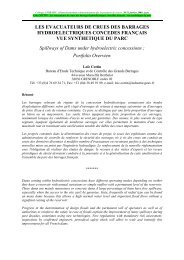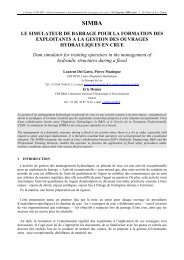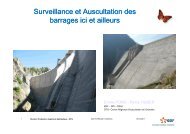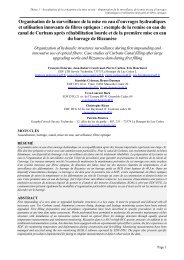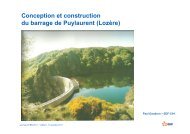SMALL DAMS
SMALL DAMS - Comité Français des Barrages et Réservoirs
SMALL DAMS - Comité Français des Barrages et Réservoirs
- No tags were found...
You also want an ePaper? Increase the reach of your titles
YUMPU automatically turns print PDFs into web optimized ePapers that Google loves.
S mall concrete dams<br />
THE CLASSIC GRAVITY DAM (CVC OR RCC)<br />
By the term classic gravity dam, we mean a conventional concrete or RCC dam with<br />
upstream face subvertical ou nearly subvertical a downstream batter of the order of<br />
0.8 1 .<br />
This is the most commonly encountered type of small concrete dam. The massive<br />
structure withstands the pressure of water and uplift thanks to its dead weight.<br />
In comparison to an arch or buttress dam, design and computation of such dams are<br />
still very simple, and no sophisticated techniques are needed to build them. The<br />
amount of formwork required is reduced, but concrete volume is greater.<br />
FOUNDATION<br />
120<br />
The classic gravity dam should be built on unweathered rock, except in special cases<br />
that require specific measures to be taken (see Foundation treatment p. 121).<br />
The requirement of good quality rock is of course less strict than for a large dam<br />
(maximum stresses are considered proportional to height as a first approximation).<br />
However, there are three arguments in favour of a good quality foundation:<br />
!" the dam's rigid structure can hardly accommodate differential movements;<br />
!"the diagram of the stresses transferred to the foundation is radically different between<br />
a situation with a full reservoir and that with an empty reservoir, which can cause<br />
fatigue in a poor quality rock as the reservoir is emptied and refilled;<br />
!" hydraulic gradients in the foundation are high and could result in internal erosion<br />
if the rock is of poor quality.<br />
When several metres depth in the foundation consist of loose soil or decomposed<br />
rock, the fill dam alternative will naturally be preferred for small and medium sized<br />
dams. In fact, except in special cases, availability of fill materials on site inspires a<br />
preference for that alternative under present economic conditions, given the performance<br />
of modern earthmoving plant. However, it is true that in some countries small<br />
earthfill dams are routinely accompanied by a massive concrete spillway, comparable<br />
to a gravity dam and usually resting on a soft foundation. This alternative, rarely<br />
used in France, is limited to dams only a few metres high, and requires special<br />
precautions to control hydraulic gradients in the foundation.<br />
1. Downstream batter is here defined on the line between the downstream toe of the dam and the point<br />
in the upstream face situated at normal reservoir water level.



